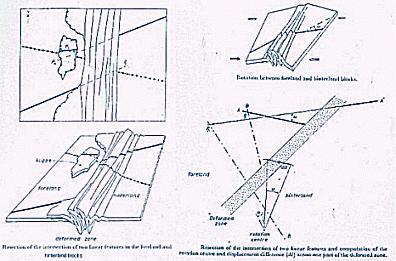FORELAND HINTERLAND AREAS
Hinterland - the direction or region from which allochthonous blocks have moved
Foreland - the direction or region toward which allochthonous blocks are moving
Example: In the Himalaya, the Indian landmass forms the foreland while the Laurasian one the hinterland.
The figure that accompanies this is actually after Ramsay (Time and Place in Orogeny 1969) which shows how the similar structures in the fore- and hinterland could be identified and restored prior to the orogenic movement.
Hinterland dipping duplexes occur when the sole fault ramps progressively into the footwall toward the foreland. The horses of the footwall are incorporated into the hanging wall.The roof thrust above the duplex structure is never active as a distinct fault entity and segments of the upper glide plane are inactive by the time they become part of the roof thrust. The activity ceases at different times on the various segments of the roof thrust. The segments above the youngest horse have the longest history of thrusting.

FORELAND THRUST BELTS
Growth of the thrust wedge occurs because stresses in the wedge (hinterland push & gravity) exceed the strength of the wedge. The wedge taper angle varies as a balance between foreland sliding of the wedge and addition of material to the toe. The surface slope of the thrust wedge is determined by: (i)the resistance to sliding on the sole fault and (ii) the strength of the rock in the wedge. The wedges thicken with high sliding resistance by internal folding, internal thrusting, backthrusting, or penetrative strain. If deformation creates an over-steepened surface slope, the wedges thin by slumping, hinterland collapse along extensional faults, erosion, or addition of new thrust slices to the toe of the wedge.
The critical tapering of the wedge required to slide the hanging wall depends on the basal shear strength of the wedge material and the material over which it moves. For example, low basal strength causes high sigmaN to get reduced because of pore water content, or movement over salt or gypsum which requires only a low slope to slide and maintain integrity (e.g. - sliding snow across ice). High basal strength - high sigmaN because of low pore water content, over basement gneiss would require a high slope to slide and maintain integrity (e.g. - slide snow across concrete). If there are differences in basal shear strength along the fault trace, changes will occur locally to make up for the compatibility problems.